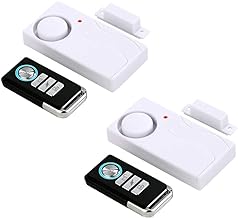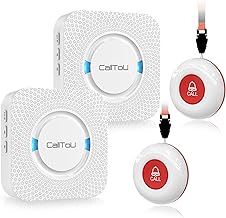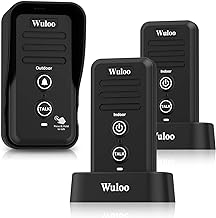5 important factors worth considering when looking for the best visual doorbell for deaf
When choosing a visual doorbell for the deaf, it’s important to consider key factors to make sure it works well. Accessibility is crucial, so picking the right visual doorbell is about more than just how it looks. The clarity of the visual indicator and the range of ways it can connect are both important in helping people with hearing impairments in their daily lives. Understanding these factors helps us see how a good visual doorbell can make a big difference, giving people more independence and security when communicating at home.
See our guide to the best visual doorbell for deaf.
Visual alerts
When looking to buy a visual doorbell for someone who is deaf, it’s important to think about how well it works rather than how it looks. While some people might like a fancy design, the main goal should be to make sure the doorbell gives clear and easy-to-see alerts for deaf or hard of hearing individuals. Choosing a doorbell with customizable visual alerts, like flashing lights or bright colors, can make it easier for the user to notice important notifications.
Additionally, getting a visual doorbell with different alert options can make the user’s experience even better. By picking a device that offers various visual alerts, such as flashing lights, LED displays, or messages on a screen, deaf individuals can set up the doorbell to suit their specific needs and likes. This not only makes the device easier to use but also shows a dedication to making sure everyone can use it. So, when picking out a visual doorbell for someone who is deaf, focus on how well it works and how customizable it is to make communication as smooth and effective as possible.
Vibration alerts
Vibration alerts in visual doorbells have changed the way deaf people can use this technology, providing a crucial solution for those with hearing impairments. As someone who is deaf, I can personally say how much of a difference this has made in my life. Getting notifications through vibrations has made it easier for me to stay connected in today’s digital world, bridging the communication gap that often leaves deaf individuals feeling isolated. Manufacturers who include vibration alerts in their visual doorbells are not just selling products, they are promoting inclusion and empowerment for deaf users.
This advancement in technology is a big step towards making sure all products are accessible to everyone, highlighting the importance of inclusivity in technology. It doesn’t just benefit the deaf community, but also shows how inclusive design can make a difference for everyone. As society becomes more aware of the importance of diversity and inclusion, it’s great to see technology evolving to meet the needs of all individuals, regardless of their abilities. Vibration alerts in visual doorbells are changing the game, making sure everyone, no matter their hearing abilities, can fully engage with the modern world of connected devices.
Customizable alert settings
When buying a visual doorbell for the deaf, it’s important to have alert settings that can be customized. Deaf people rely on visual cues to know what’s happening around them, so being able to adjust the alerts to their liking is crucial. By letting users choose how strong, what color, and how often alerts happen, manufacturers can help deaf people feel more connected to their homes in a way that works for them. Customizable alert settings also show a commitment to including everyone and making sure technology helps everyone in a meaningful way.
As technology grows, it’s great to see improvements that meet the needs of different groups of people. When companies include customizable alert settings in visual doorbells, they are not just meeting a need – they are also showing that inclusivity is important in smart home devices. Recognizing that everyone has different experiences and making an effort to accommodate those differences through customizable features shows a proactive approach to creating an environment that is accessible and easy to use for everyone.
Compatibility with other smart home devices
When thinking about buying a visual doorbell for people who are deaf, it’s important to make sure it can work well with other smart home devices. Connecting your visual doorbell to other smart gadgets can make your home automation system work better and be more convenient. Picture getting immediate visual alerts on your smartwatch or phone whenever someone rings the doorbell. By easily combining this feature with your other smart devices, you can have a more connected and organized experience. Being able to manage your visual doorbell along with things like smart lights, security cameras, and voice assistants creates a cohesive and useful smart home setup that fits your specific needs and likes.
Additionally, connecting smart devices together can make things more accessible and convenient for people with hearing problems. By linking your visual doorbell to devices like smart speakers or vibrating alerts, you can make sure you never miss important notifications. This level of compatibility not only makes your visual doorbell work better, but also helps create a more inclusive and accessible living area for people who are deaf. The power of integration is in its ability to blend different technologies, making them work together to give you a more advanced, easy-to-use, and efficient smart home experience that meets the needs of all users.
Long battery life
When looking into buying a visual doorbell for someone who is deaf, it’s important to consider how long the battery lasts. Having a doorbell with a battery that can keep going for a long time is crucial. People who rely on visual signals for when someone is at the door need a device that won’t run out of power often. It would be bad to miss an important visitor because the visual doorbell lost power at a critical moment. Getting a visual doorbell with a long-lasting battery not only gives peace of mind but also makes sure it keeps working when you need it most.
A visual doorbell with a strong battery capacity is convenient and reliable, making it easier to keep track of power levels. This feature is especially important for people with hearing impairments who need visual alerts for communication every day. Many visual doorbell options now have power-saving technology that extends battery life without affecting performance. By focusing on long battery life when choosing a visual doorbell for the deaf, users can improve their overall experience and stay connected with the world seamlessly. A dependable battery guarantees that every press of the doorbell results in a quick and visible alert, helping people with hearing disabilities move around confidently and independently.
Conclusion
In an ever-changing world of technology, the visual doorbell for the deaf offers inclusivity and innovation. This device helps deaf people communicate with visitors at the door, making it safer and easier for everyone. It shows progress towards a world that welcomes everyone. Embracing these solutions doesn’t just help the deaf community – it also makes society better as a whole. It reminds us that empathy and designs focused on people can create a more inclusive future. Want more info on gel nail polish kits, check the best gel nail polish kits.



